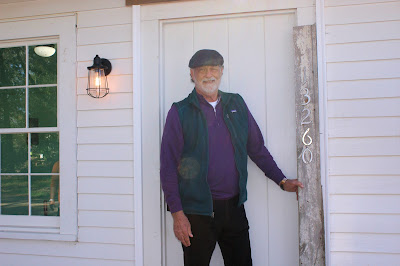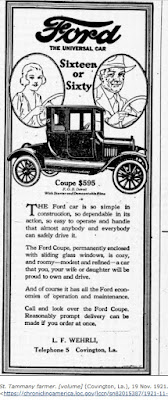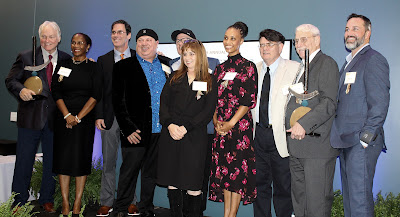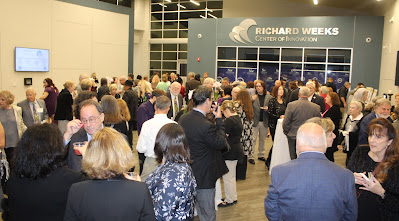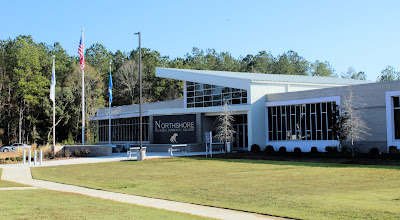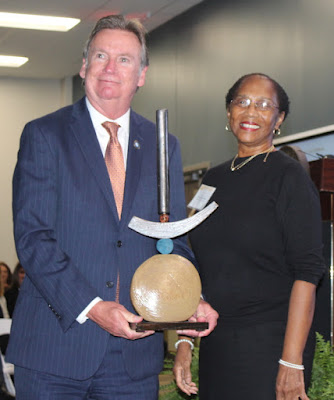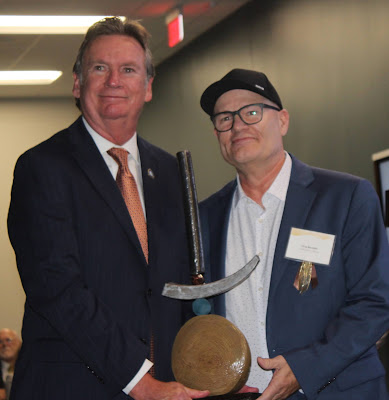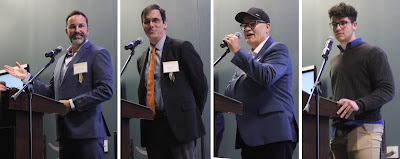What was going on 100 years ago this week? CLICK HERE for a link to the St. Tammany Farmer Issue of November 26, 1921. The link is provided by the Library of Congress and its Chronicling America service.
Click on the sample images below to see larger versions.
Monday, November 29, 2021
100 Years Ago November 26, 2021
Tuesday, November 23, 2021
Bridge Politics In 1927
In 1927 controversy was swirling about the need to build a bridge over Lake Pontchartrain between New Orleans and the Northshore. Several locations for the endpoints were proposed, and state and local politicians had definite opinions of where best to place the bridge, how to finance it, and how to protect that investment from future competition.
And so it was in St. Tammany Parish. A proposed toll bridge built by private interests wanted to be protected against any future "free" bridges built by the state (within 30 miles), and that generated considerable debate.
Built in 1928, the Watson-Williams bridge did just that, and people were outraged that the new bridge would only serve the east end of the parish and prevent any other bridges from being built to serve the Mandeville area. Complicating the matter was the demand for free bridges to be built at the Chef Menteur/Rigolets crossing near Fort Pike.
This editorial in the January 1, 1927, edition of the St. Tammany Farmer explains the situation, and it mentions some interesting facts.
It is psychologically inconsistent to attempt to popularize anything against the will of the people. There may be no legal way of preventing it and it may be forced upon them, but if its success depends upon the attitude of the people, then the good will of the people most be gained.
Having an interest in the development of St. Tammany pariah as a whole, we view with alarm the building of any toll bridge that is protected from competition by an exclusive franchise that forbids the building of any other bridge within thirty miles.
We have always opposed the granting of any franchise for a toll bridge that practically cuts off all traffic between St. Tammany and New Orleans except at the extreme east of the parish, and with this in view we believe the granting of such a franchise for the building of the Watson-Willliams bridge was an outrage upon the people.
That we were justified in this vlewpoint was strengthened by the protest of citizens at mass meetings In New Orleans, at public gatherings and in the press.
The desire to build this bridge in the face of public sentiment against it, and in the face of the fact that one of its principal supporters, an attorney for the company, made the statement at a public bearing that their bridge could not be built "if the free bridges were built at the Chef-Rigolets" is a puzzle that has not been solved by people interested In developments in St. Tammany parish and New Orleans.
Caligula built a bridge between Baise and Puteola, but surely the big financial interests behind this venture can not be accused of dementia. It is reasonable to conclude that there is something behind this bridge beyond the profits of automobile traffic, especially when a bridge could have been built between Goose Point and Milneburg with an avoidance of the completion of a free bridge within six miles or so, and with the assurance of heavy traffic and large developments in both St. Tammany and New Orleans. The people would like to know what influences are behind such a situation.
It does not seem reasonable that the demand for direct communication between New Orleans, St. Tammany and the Coast country can be stifled. Eventually the bridge from Goose Point to Milneburg will be built, and pending that accomplishment sea planes and ferries of some kind that will take care of passenger and automobile transportation will be devised and put into service.
The farmers of St. Tammany would be greatly benefited by a bridge at this point. It would enable them to marker their products daily in New Orleans and to place vegetables and fruit on the table within a few hours after they were taken from the field. It is beyond reason to believe that a beautiful body of water such as Lake Pontchartrain should be made unavailable to the use of the people in order to secure profits to a private Corporation or to force developments in an other direction.
The ST. TAMMANY FARMER, January 1, 1927
A proposed bridge was being sought between the port of Milneburg in New Orleans and Goose Point south of Lacombe. "Eventually the bridge from Goose Point to Milneburg will be built," the editorial states. That would have changed the future of Lacombe, for sure.
Well, they came pretty close to being right.
Until that bridge was built, the editorial went on to say, ferries and sea planes would have to provide transportation across the lake, as well as move St. Tammany products to the markets of New Orleans.
The editorial furor continued, with another analysis published just 29 days later.
Here is the text of that editorial above:
ST. TAMMANY WILL FIGHT TO THE END
Even it ferries and hydroplanes must be the final resort, St. Tammany will fight to the last for direct communication with New Orleans either at Goose Point, or Mandeville.
New Orleans must finally join in this fight to aid in her own development. It will not only be necessary to her own expansion in meeting suburban demands; it will be jointly important in Gulf Coast development and in the popularization of the route from Mobile into Louisiana.
But It is of immediate importance that no change be made in our plans for free bridges at the Chef and Rigolets, lost in a partisan legislature but emphatically endorsed by the people at the polls. Some interests have been persistent in efforts to divert developments from St. Tammany parish—to prevent free bridges and force developments in another direction. We have letters in evidence of this which we may at some time publish.
Beware of your enemy when they come bearing gifts. It may not be expected that we should receive unquestioned, proposals from those who have opposed us. We now have an administration pledged to our free bridge plans.
The Highway Commission is capable and informed and may be trusted to carry out the law and conform to its provisions for free bridges connecting up the highways as originally intended and for which federal aid was given. We know that if this is done we will be entirely within the law and beyond the reach of petty legal interference.
We do not know what complications may arise from deviations. The aerial route suggested is something for the future and entirely apart from our immediate operations. Nobody would be opposed to free ferries if nothing else were involved, and they were not used as propaganda against the necessity of building bridges.
We do not Iook with favor upon any proposition that increases the distance between Slidell and the free bridges. St. Tammany has contributed to the building of this highway and deserves to share in the benefits to be derived.
Under the caption, "'Where Confusion- Division," an editorial in Wednesday's edition of The Times-Picayune ably discusses this matter. We publish it in full below:
Since the announcement in mid-January that the Highway Commission's engineering force actually had begun surveys and borings for the Chef-Rigolets bridges, it has been proposed that the community launch an agitation for immediate free ferries at those crossings.
Free Ferries
The project was initiated, in the public prints at least by a gentleman who wrote himself opposed to free bridges even while he demanded tree ferries. The latter idea has its appeal, of course. The imposition of tollage upon public highways, whether for bridges or ferries, goes against the grain and wins tolerance only as a temporary, and temporarily unavoidable nuisance. But have those supporters of the Chef-Rigolets free bridge cause who welcomed the free terry scheme offhand ever taken time to study its bearings upon the first and vastly more important project—and to wonder why free ferries are demanded just as the bridge surveys are begun-wand by the evolved opponents of free bridges?
The contract covering the Chef-Rigolets ferries and awarded by the former Highway Commission has yet more than a year to run, expiring in March, 1928. It is, we assume, a binding document enforcible in the courts. To grant the sudden demand for immediate free ferries, the present commission would have to make terms with the contractor, purchase ferry equipment and organize the operating force.
The money for all this would have to come, we fear, from highway Fund No. 2, from which the bridge construction must be financed. Any attempt to set up free ferries at the Chef and Rigolets out of the general highway fund would inevitably and naturally provoke demands that the commission finance free ferries throughout the state, embroiling us with our neighbors and arousing distrust and hostility akin to that created by the false charges, last summer, that New Orleans was trying to raid the general highway fund for the bridges.
In brief, and whether that was the motive behind the "immediate tree ferry" proposal or not, its adoption as a community slogan would stir up confusion and strife and place further obstacles in the way of the commIssion's announced plan to press forward as rapidly as possible to the construction of the bridges which will end once for all the temporary imposition of ferry tolls.
Against any effort to divide the supporters of the bridges and by dividing to block or defeat Governor Simpson's program for their early construction, Orleanians should be constantly watchful.
Now has come the supplementary proposal of the mayor's advisory bridge committee for a change of the Rigolets bridge location in order that it may serve a "short cut" to the Mississippi coast. If it be settled and accepted that the proposed "short cut" is not to interfere with nor delay completion of the present highway route to Slidell, this recommendation consists with the suggestions of the federal engineers who inspected and approved the present route, and with the announced plan of the Highway Commission.
The commission already has arranged with the war department for an aerial survey of the "short cut," and is planning to fix the location of the Rigolets bridge with that project in mind.
But care must be taken to prevent this supplementary "short cut" plan, admirable in its proper time and order, from becoming entangled or twisted into a scheme for abandoning the present route to Slidell entirely and substituting therefor a brand new highway which would lengthen materially the journey to Slidell and thus defeat one of the prime purposes of the existing and officially adopted route.
Let it be remembered that the federal engineers, who first broached the "short cut" idea, expressly declared in their support that "it will not take the place of the connection between Slidell and the Rigolets, as this link is necessary to provide connection with the Louisiana system at Slidell."
Whether or not the new suggestions are intended to divide the Chef-Rigolets bridge supporters against themselves and raise up new obstructions and delays, let us all try to keep the vital bridge objective clearly in mind and maintain a solid front in its support, instead of shooting off at tangents, losing unity and direction and thereby helping the anti-free bridge forces and interests to defeat the movement for those urgently needed spans just as the final victory of the free bridge campaign is in sight.
End of editorial comment
The people of the west end of St. Tammany Parish wanted their bridge and they wanted it now. Twenty-nine years later, they got it.
See also:
Planning to build the Causeway Started Early
The Watson-Williams Bridge
Pearl River, LA: Gateway to the Miss. Gulf Coast
Saturday, November 20, 2021
Old Folsom Library Updated
In the latest report on the restoration and preservation of the old Folsom library building behind the Giddy Up coffee house, Frank Richerand said that work is nearing completion and a grand opening event is being planned for early December.
The small building served as Folsom's community library for many years and had fallen into ruins, but Richerand and a number longtime Folsom residents (as well as a few newcomers) have been working to save the building and turn it into some sort of museum or reading room.
Special care was taken to use all the original materials as much as possible, in the expectation that the state historical association will designate the structure as a key community heritage resource, since it played such a large part in bringing school children and adults alike library services long before the St. Tammany Parish Public Library System was able to serve Folsom.
The town now has a much larger library building, opened in 1987, that took over the book lending services, but many oldtime Folsom residents remember visiting this library building, especially those who walked from the Folsom Elementary School to borrow books before the school had a library.
Pat Chiri Remembered
"To many I was that crazy newspaper reporter and photog with the old Slidell Daily Times and Slidell Sentry News, driving wildly to accidents on the old Twin Spans or hurricanes to let everyone know I was rough and ready," she wrote. "Then there were the homicides and other tragedies, local and parish government meetings (always good for excitement), and most of all, my life’s mission, saving all the animals in the world."
She spent almost every day at the Slidell Animal Shelter,
her "second home."She also ran the Chiri Critter Care
pet sitting service, "but
there were too many days shedding tears over man’s inhumanity to his own
species, much less animals," she wrote.
When she moved to Florida, she left as Kevin became an editor and publisher with his own newspaper, The Slidell Independent. "Your small town community newspaper is still the backbone for us to carry on setting all things right," she concluded.
I worked with Pat on some of the same news stories when I was a reporter for the Mandeville Banner and St. Tammany Farmer, and I knew her dedication to her craft as well as to the animal welfare of the dogs and cats (and other four legged creatures) of the Slidell area.
Mary Patricia “Pat” Berg Chiri, age 89, of Slidell, LA, passed away on Wednesday, August 25, 2021. In her obituary, it was noted that she was a native of Port Chester, NY, and resided in St. Cloud, FL, and Kissimmee, FL, before moving to Slidell in 1969. She retired to Englewood, FL, in 2007 before coming back to Slidell in 2020.
After graduating from St. Cloud High School, she attended the University of Florida before working professionally as a news reporter for the Osceola Sentinel in Kissimmee, then writing for the Slidell Daily Times and the Slidell Sentry-News.
"Pat
had a lifelong love of animals and was the founder of the Animal
Assistance League of Slidell, besides gaining a following with her
weekly pet column in the Slidell newspapers," according to her obituary. She also owned and operated
her own small business, “Chiri Critter Care” for many years in the
Slidell area. The pet sitting service is now run by her granddaughter Vicky.
Additionally, Pat worked at the Slidell Airport and was a licensed pilot, and spent years as a Reserve Deputy for the St. Tammany Sheriff’s Office.
She will be long remembered by many Slidell citizens for her many contributions to the community.
See also:
Patricia B. Smith
Friday, November 19, 2021
100 Years Ago This November 19, 2021
What was going on 100 years ago this week? CLICK HERE for a link to the St. Tammany Farmer Issue of November 19, 1921. The link is provided by the Library of Congress and its Chronicling America service.
Click on the sample images below to see larger versions.
Thursday, November 18, 2021
The Arts Awards for 2021
The St. Tammany Cultural Arts Commission, on behalf of Parish President Mike Cooper, presented me with a Lifetime Achievement award tonight at Northshore Technical Community College in Lacombe. I was among ten individuals who were selected for awards in various categories, art, music, culinary expertise and writing.
From left to right, Ben Bensen III, Dr. Eva Semien Baham, Charles Dowdy of Lake Radio 94.7, Ricky Windhorst III, Greg Barnhill, Mary Monk, Kenya Lawrence Jackson, Ron Barthet, Stephen Cefalu, and Jeffrey Hansell.
Patron of the Arts Award
"I'd like to thank Mike Cooper for this recognition, and congratulations to all of tonight's award winners.
I'd like to mention three groups of people who helped me throughout my career.
The first group are the hundreds of people I interviewed over the years. I thank them for sharing with me their stories: their hopes, their dreams and their concerns.
The second group are the thousands of people I have photographed over the years. I thank them for sharing with me - their smiles.
The third group are the artists, writers, photographers, and all the creative people of St. Tammany parish, many of whom are community leaders like Pat Clanton, Mark Johnson and Carol Jahncke. They inspired me and many others to be creative everyday.
The scenic beauty, the peacefulness and livability of St. Tammany attracts artists of every kind. Every day creative photographers scour the parish capturing hundreds of spectacular images, photographers like John Snell and Anthony Leone.
Actually, St. Tammany Parish has a long history of attracting artists and poets and writers, people who over the past 200 years have been drawn here, painting on canvas, writing in verse and sending letters back home telling about the great place they had found.
How do we know this? Because of the work and research of the historians of St. Tammany Parish, people like Steve Ellis, C. Howard Nichols, Bertha Neff, Paula Johnson, Tom Aicklen and my friend Don Sharp. They help us realize where we came from, how we got to where we are today, and perhaps how we move forward into the future.
And speaking of history...
If you haven't yet visited my blog over at TammanyFamily.com, I would like to invite you to do so. You will probably find something of interest, maybe even, a photograph of yourself."
End of speech
At that point I aimed the camera at the audience and took a picture.
Here are some additional photographs of people attending the arts awards event:
I want to add this list of some of the individuals who have helped me with specific projects and various personal accomplishments.
Lou Major Sr. and Lou Major Jr., who gave me my first newspaper jobs
Lane Carson, attorney and advocate for veterans
A.G. Crowe, who published dozens of my cartoon maps
Bob Sander, house designer with Poole Lumber Company
Wallace Poole, owner of Poole Lumber Company and community supporter
Warren Salles, owner of Star Theater
Vera Hardman, Natalie Hebert and Brenda Willis with the St. Tammany Farmer
Walker Percy, who read a few of my short stories
Mark Johnson, mayor of Covington and storyteller extraordinaire
Jack Akers, artist who painted Louisiana environmental scenes
Lyn Hill Taylor, artist who wrote the Art Colony column for the Covington Daily News
Bertha Neff, courthouse archivist
Don Sharp and Pat Clanton, who shared with me their friendship and photo album scrapbooks
Carol Jahncke, community promoter, writer and puppeteer
https://tammanyfamily.blogspot.com/2021/10/arts-awards-for-2021.html
Sunday, November 14, 2021
Three Rivers Art Fest - 2021
The 25th annual Three Rivers Art Festival graced the streets of Covington once again, bringing outstanding artists in a wide variety of media to the area for one of the South's finest juried art shows and sales.
Here are some photographs of the this year's event and its offerings. Click on the images to make them larger.
"Now we are up to 500 artists applying every year. It's a juried event so only 200 get in," he explained.
It has become nationally known and nationally recognized, something that people look forward to each year. "They put this event on their calendar as soon as we announce next year's dates," he said.
For St. Tammany Parish and particularly Covington, the festival brings in from 50,000 to 60,000 people over the weekend so the tax revenues derived from it are tremendous, Bergeron went on to say.
Now in its 25th year, this has been an ongoing project that continues to grow every year, according to Bergeron. "If you want to invest in a very high quality piece of art you can do it there. We have everything from ten dollar pieces of jewelry to $50,000 pieces of art," he noted.
It's also a great family event. "So you bring out your kids. It's a wonderful place to go and there's something for everybody," Bergeron concluded.
This event has three purposes, all of which are connected to the festival’s home parish, St. Tammany, and all that this community has to offer. First, the festival serves to expand and enhance St. Tammany’s reputation as an arts-oriented community and mecca for artists and art lovers. Columbia Street, along which the artists’ booths run and the music plays, is filled with art throughout the year from multiple galleries to art supplies. Essentially, this one street is any art enthusiast’s heaven. The festival also adds to the many other attractions and events that make St. Tammany a wonderful tourist destination.
Lastly, the festival supports art education for St. Tammany Parish school students. By hosting a student art competition that is displayed during the festival, the event inspires and encourages children of all ages to experiment with and create art.
At the festival itself, the Children’s Area offers hands-on activities, and the Arts Alive! program provides live demonstrations by exhibiting artists during the day so kids can either watch or participate in artistic creation.
The Covington Three Rivers Art Festival is promoted through an extensive media campaign that targets sophisticated, knowledgeable buyers in the Greater New Orleans area, South Louisiana and the Gulf Coast.
This festival is a non-profit 501(c)(3) organization that is run by a volunteer board and part-time coordinator, supplemented by more than 150 additional volunteers committee members and workers. Funding is generated by event sponsorships, donations, grants and exhibited booth fees.
Mission Statement:
"The purpose of the Covington Three Rivers Art Festival is to expand and enhance the reputation of St. Tammany Parish as an arts oriented community and mecca for artists and art lovers to serve as an attraction for cultural tourists to St. Tammany Parish; to support artists in St. Tammany Parish and outside of St. Tammany Parish; and to support art education for students living in St. Tammany Parish or attending a St. Tammany Parish school."












